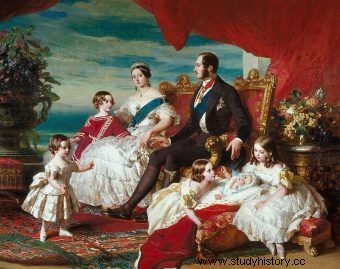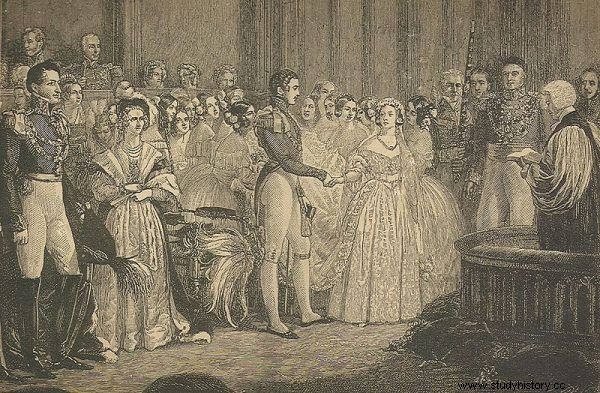Even though Queen Victoria had nine sons and daughters, she didn't really like children. She was afraid of having children, and reacted with irritation to each subsequent pregnancy. The babies that annoyed her the most, she compared to… toads.
Before her wedding with Prince Albert, the almost 21-year-old monarch did not hide that she would like to get pregnant no sooner than in 3 years. In her diary, she confessed that having children is "the only thing she is afraid of in marriage" . However, neither the young queen nor her husband knew anything about pregnancy prevention, so Victoria gave birth to a daughter on November 21, 1840 - exactly nine months after the ceremony ... "I felt trapped," she confessed later. Where did her aversion to children come from?
Forced Isolation
Queen Victoria's biographers agree that the sources of this aversion lie in the ruler's childhood. Her father died when she was only 8 months old. The girl's mother, née Princess of Saxony-Coburg-Gothy, felt lost at the English court. She spoke poorly in the language of the sons of Albion and dreamed of returning to her native Germany. But her daughter was, after all, the heir to the throne, so leaving was out of the question.

Queen Victoria did not like children, although she had as many as nine
Victoria's mother began to depend on a Captain John Conroy, whom she made steward. The man had such an influence on her that on his initiative the future monarch was isolated from the rest of the royal family, and her only playmates were the daughters of Conroy. Meanwhile, the girl craved contacts with other children and made plans about how she would surround herself with her peers in adulthood. This is probably why she wanted to spend as much time as possible with her beloved Albert, before their offspring appeared in the world ...
"Children are really less important than the husband"
Life had other plans for her. Reluctant to motherhood, the queen bore one after another as many as nine children:Victoria (1840), Albert Edward (affectionately known as Bertie, 1841), Alice (1843), Alfred (1844), Helena (1846), Luisa (1848), Arthur (1850) , Leopold (1853) and Beatrice (1857). Like other women in her circle, she did not breastfeed because she considered it an almost animal activity. When, years later, her daughter Alicja decided to feed her children herself, the monarch did not hide her indignation and named after her ... a cow in Windsor.

Albert and Victoria's wedding
The Queen hired a whole staff of nannies. She saw her crowd twice a day - in the morning, when the nannies brought the little ones to say hello to their mother, and in the evening, when the children said "good night" to her.
When the eldest descendants, Victoria, Bertie, and Alice, reached their teens, their mother sometimes allowed them to spend the evening with their parents. But - as she admitted in a letter to her friend, the Queen of Prussia - did not enjoy being with children and preferred to be alone with her "beloved" and "dearest" Albert.
Unlike the Queen, her firstborn daughter loved motherhood and happily welcomed each of her eight children into the world. According to the ruler, it was inappropriate. Moreover, when Wiktoria lost 21-month-old Sigmund, her mother tried to convince her that "children are really less important than her husband" and she did not understand why she was despairing.
Poor Bertie
Heir to the throne, Albert Edward, was Victoria and Albert's greatest hope. The couple decided to give him the best education, and the queen dreamed that the son would become a living copy of her idolized spouse. To this end, an intensive education plan for the future king was implemented, and his teachers and tutors were explicitly instructed by the boy's parents to demand a lot from the prince and to judge him strictly.
But although Bertie was an intelligent child, he was not very fond of his studies and was not particularly successful - unlike his older sister. Meanwhile, the less enthusiastic reports were written by educators, the more classes were put on him. As you can easily guess, the intensification of the curriculum had the opposite effect:the tired boy only got even more discouraged .

Victoria rarely admitted children. She preferred to spend time alone with her husband.
Victoria increasingly showed disappointment with the heir to the throne. The worst was to come in the fall of 1861, when Bertie got into an affair with actress Nellie Clifden during his stay in Cambridge. The parents were devastated by their son's behavior. Soon Albert went to Bertie to have a moralizing conversation with him. He had a bad cold already before the trip, and after returning home his condition worsened. The efforts of the court physicians were of no avail - on December 14, 1861, the royal husband died.
The ruler fell into despair. She blamed Bertie for the death of her beloved husband. "I shudder when I hear the sound of his footsteps," she confided to her eldest daughter. "I don't know if I'll ever forgive him." Over the next 40 years, the monarch openly showed aversion to her son, including by not informing him about the most important state matters and by not entrusting him with serious tasks.
Escort
Interestingly, when the children grew up, the Queen changed her attitude a bit. Firstborn Victoria married the heir to the throne of Prussia, lived in Berlin, and rarely visited her parents, but the monarch needed her other daughters to keep her company - and were there at her every beck and call.
For this reason, she decided that Alice would marry a minor German ruler who would not have many duties at his court and, therefore, could spend a lot of time in his mother-in-law's palace. The prince of Hesse, Ludwik, became the queen's son-in-law. During the first year of their marriage, Alice and her husband did spend a lot of time in England, but soon they started building their own house in Darmstadt and the visits stopped.
Another daughter, Helena, also married a German prince and moved to live near the queen. However, the arrival of more children prevented the young mother from fulfilling her parent's whims. Then Wiktoria decided that the youngest Beatrice would be her companion, who - according to the plans of the ruler - was to remain a virgin forever. In order not to think about getting married, the Queen forbade my relatives and servants to pronounce the words "engagement", "wedding", "fiancée" in front of her.
Beatrice submitted to her mother's will - for a time. At the age of 27, she fell in love with Henryk Battenberg. The queen did not want to hear about the marriage and for six months ... she stopped talking to her daughter (the women communicated by means of notes that were handed over to them by their servants). But this time the usually obedient Beatrice got her way.
The wedding took place on the condition that the young couple would live under the roof of Victoria. The bride and groom did not argue. Unfortunately for Henry, a former officer, the quiet life in the royal palace became a source of great frustration. But that's a completely different story…
Bibliography:
- Dennison M., The Last Princess:The Devoted Life of Queen Victoria's Youngest Daughter. London, 2007.
- Duff D., Albert and Victoria . London 1972.
- Packard J.M., V ictoria`s Daughters . New York, 1998.
